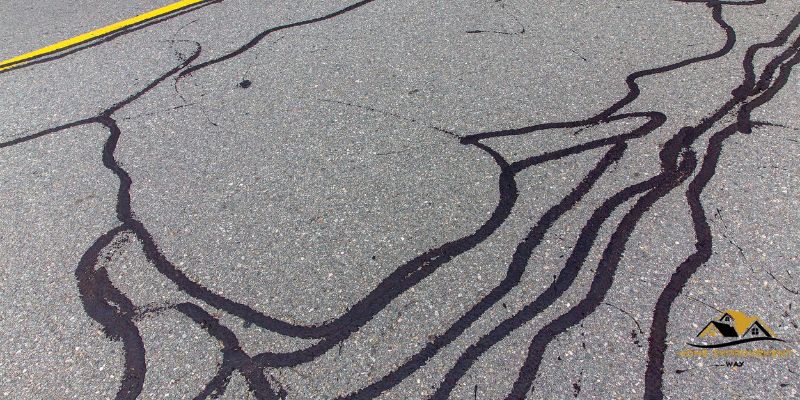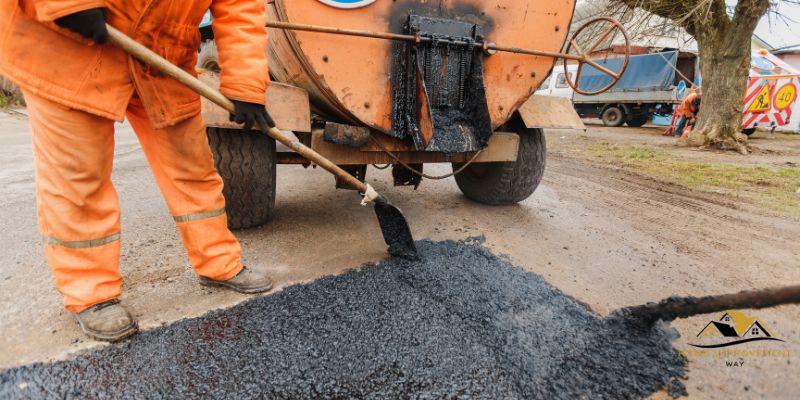To fill depressions in an asphalt driveway, follow these steps: Clean the depressed area, apply an asphalt cold patch or crack filler, and compact the material with a tamper or roller. Maintaining a smooth and level asphalt driveway is essential for both the aesthetic appeal and functionality of your property.
Over time, depressions or potholes may form, causing an uneven surface and potential damage to vehicles. Fortunately, you can easily rectify these depressions by following a few simple steps. By cleaning the affected area, applying the appropriate filler material, and compacting it effectively, you can restore the stability and visual appeal of your asphalt driveway.
In this guide, we will outline the process of filling depressions in an asphalt driveway, ensuring a durable and long-lasting solution.
Identifying The Depressions
Depressions in an asphalt driveway are easily identifiable and can be filled using simple techniques. Repairing these depressions not only improves the appearance of the driveway but also prevents further damage. Follow these steps to efficiently fill depressions and restore your asphalt driveway.
Visual Inspection
Identifying and addressing depressions in your asphalt driveway is crucial to maintaining its quality and preventing further damage. A visual inspection is the first step to understanding the extent of the problem. By carefully examining your driveway’s surface, you can locate areas where depressions have formed. Look for areas that appear lower or sunken compared to the surrounding pavement. These depressions can vary in size, from small divots to larger patches, and may be more noticeable after rainfall.

Measuring The Depth
Once you have identified the depressions, it is essential to measure their depth accurately. This measurement will help you determine the best method and the amount of material needed to fill the depressions. To measure the depth, you can use a simple tape measure or ruler.
Start by placing one end of the tape measure at the highest point of the depression and extend it to the bottom. Note down the measurement in inches or centimeters. Repeat this process in multiple areas to ensure consistency.
A table can be used to present the measurements and locations of each depression:
| Location | Depth (inches) |
|---|---|
| Area 1 | 2.5 |
| Area 2 | 1.8 |
| Area 3 | 3.2 |
By measuring the depth of each depression, you can prioritize which areas require immediate attention and those that may be addressed later. Once you have assessed the depressions, you can proceed with the necessary repairs to ensure a smooth and even driveway surface.
Preparing The Driveway
Learn how to fill depressions in your asphalt driveway with these easy steps. Say goodbye to those unsightly dents and maintain a smooth and even surface for your driveway. Follow our guide and enjoy a perfectly prepared driveway.
Cleaning The Surface
Before filling depressions in your asphalt driveway, it is crucial to properly prepare the surface. Cleaning the surface ensures that the repair material adheres well and provides lasting results. Here are some easy steps to clean your driveway:
- Start by removing any loose debris, such as sticks, leaves, or small rocks. Use a broom or a leaf blower to sweep the entire surface, making sure to reach all the corners.
- Next, inspect the driveway for any oil stains or grease spots. These can prevent the repair material from adhering properly. If you find any stains, use a degreaser specifically designed for asphalt and scrub the affected area with a stiff brush.
- For tough stains that do not come off easily, you can use a pressure washer. Make sure to follow the manufacturer’s instructions and keep the nozzle at a safe distance to avoid damaging the asphalt surface.
- Once the surface is free from debris and stains, use a water hose to rinse off any remaining dirt or cleaning solution. It is essential to let the driveway dry completely before proceeding with the repairs.
Removing Loose Debris
One of the crucial steps in preparing an asphalt driveway for filling depressions is removing loose debris. This ensures a clean and stable surface for the repair material. Follow these simple steps:
- Begin by inspecting the driveway for any loose gravel or rocks. Use a broom or a leaf blower to remove this debris.
- If there are any cracks or potholes on the surface, use a stiff brush or a scraper to dislodge any loose asphalt fragments. Make sure to clear out all loose debris from these damaged areas.
- For better results, you can also use a wire brush to remove any ingrained dirt or loose particles that may hinder the repair process.
- Once you have removed all the loose debris from the depressions and the surrounding areas, clean the entire surface again using a broom or a leaf blower. This ensures that no loose debris makes its way back into the depressions during the repair process.
Choosing The Right Filling Material
When it comes to filling depressions in your asphalt driveway, choosing the right filling material is crucial for long-lasting and effective repair. Different materials offer varying benefits and drawbacks, so it’s important to understand the options available to you. In this section, we will explore three commonly used filling materials: Cold Asphalt Patch, Hot Mix Asphalt, and Aggregate Fillers.
Cold Asphalt Patch
If you’re looking for a quick and easy solution to fill depressions in your asphalt driveway, a cold asphalt patch is a popular choice. This material comes pre-mixed and ready to use, making it convenient for DIY repairs. Simply fill the depression with the cold asphalt patch, compact it firmly with a hand tamper or a plate compactor, and you’re done! Cold asphalt patch is resistant to water and UV rays, making it a durable option for filling small cracks and depressions.
Hot Mix Asphalt
If you’re dealing with larger depressions or severe damage to your driveway, hot mix asphalt is worth considering. This material is composed of a mixture of heated asphalt cement, sand, and aggregate. Hot mix asphalt offers superior strength and durability, making it ideal for heavy traffic areas. Professional installation is recommended for hot mix asphalt, as it requires specialized equipment and expertise. The hot mix is poured into the depression, leveled, and compacted using heavy machinery, resulting in a smooth and sturdy surface.
Aggregate Fillers
Another option for filling depressions in your asphalt driveway is using aggregate fillers. These fillers are made up of small stones and are commonly used to fill larger depressions or potholes. Aggregate fillers provide excellent structural support and are resistant to cracking and shifting. To use aggregate fillers, clean the depression and apply a layer of tack coat, then fill the depression with the aggregate material. Finally, compact the fill material to ensure a solid and even surface.
In conclusion, choosing the right filling material for your asphalt driveway repairs is essential for a successful outcome. Depending on the size and severity of the depressions, you can opt for a cold asphalt patch for quick fixes, hot mix asphalt for more extensive repairs, or aggregate fillers for durability and structural support. Consider your specific needs and consult with a professional if necessary, to ensure your driveway remains in great shape for years to come.

Applying The Filling Material
An important step in filling depressions in an asphalt driveway is the application of the filling material. This is the stage where you actually fill the depressions and restore the smoothness of your driveway surface. By following the proper techniques, you can ensure a durable and long-lasting repair. In this section, we will discuss two effective methods for applying the filling material: using a trowel and the layering technique.
Using A Trowel
Using a trowel is a straightforward yet effective way to fill depressions in your asphalt driveway. Here’s how you can do it:
- Begin by preparing the filling material according to the manufacturer’s instructions. It’s important to use the right type of filler for your driveway’s condition.
- Wear a pair of gloves to protect your hands and apply a generous amount of the filling material into the depression with the help of the trowel.
- Start spreading the material evenly, ensuring that it covers the entire depression.
- Use the trowel to compact the filler, pressing it firmly to create a tight bond with the existing asphalt surface.
- If needed, add more material and repeat the process until the depression is completely filled and level with the surrounding driveway.
This method allows you to have better control over the filling process and ensure an even distribution of the material. Take your time and remember to apply enough pressure during compaction to achieve a seamless repair.
Layering Technique
The layering technique is another effective approach for filling depressions in your asphalt driveway. Follow these steps:
- Prepare the filling material as per the manufacturer’s instructions, ensuring it is suitable for your driveway’s needs.
- Start by pouring a small amount of the filling material into the lowest part of the depression.
- Spread the material evenly, creating a thin layer that covers the entire depression.
- Using a compactor or tamper, gently press down on the layer to compact it and create a firm base.
- Continue adding thin layers of the filling material, compacting each layer before adding the next one. Repeat this process until the depression is filled and level with the surrounding asphalt.
The layering technique allows for a gradual build-up of the filling material, resulting in a sturdy and smooth repair. Take your time to ensure each layer is properly compacted before moving on to the next one, as this will contribute to the longevity of the repair.
Smoothing And Sealing The Patch
Patch and fill depressions in your asphalt driveway with a smooth and durable solution. Smoothing and sealing the patch will ensure a seamless finish and long-lasting results.
Using A Vibrating Plate Compactor
One of the most effective ways to ensure a smooth and long-lasting patch on your asphalt driveway is by using a vibrating plate compactor. This tool applies pressure to the patch, helping to force the material into any depressions and create a level surface. Here’s how you can use a vibrating plate compactor to achieve the best results:
- Start by positioning the compactor at one end of the patch.
- Hold onto the handle firmly and start the compactor by pulling the cord.
- Slowly push the compactor forward, making sure to cover the entire patch area.
- Repeat this process, overlapping each pass slightly, until the entire patch has been compacted.
- Make additional passes with the compactor if necessary, focusing on any areas that still appear uneven.
Applying Sealcoating
Once you have smoothed out the patch, the next step is to apply seal coating. Sealcoating not only enhances the appearance of your asphalt driveway but also protects it from the elements and extends its lifespan. Follow these steps to successfully apply seal coating:
- Clean the patch thoroughly, removing any debris or loose material.
- Mix the seal coating material according to the manufacturer’s instructions.
- Using a brush or squeegee, apply a thin and even coat of seal coating to the entire patch.
- Make sure the seal coating extends slightly beyond the repaired area for seamless blending.
- Allow the seal coating to dry completely before using your driveway.
Remember, regular maintenance is key to keeping your asphalt driveway in optimal condition. By smoothing and sealing any depressions, you can prevent further damage and ensure a smooth and functional surface for years to come.
Conclusion
Addressing depressions in your asphalt driveway is an essential maintenance task that can greatly improve its appearance and functionality. By following the steps mentioned in this blog post, including cleaning the area, filling it properly, and sealing it, you can achieve a smooth and durable surface.
Remember to take extra care in choosing the right materials and tools for the job. With a little patience and effort, you can effortlessly restore the beauty and integrity of your driveway.


